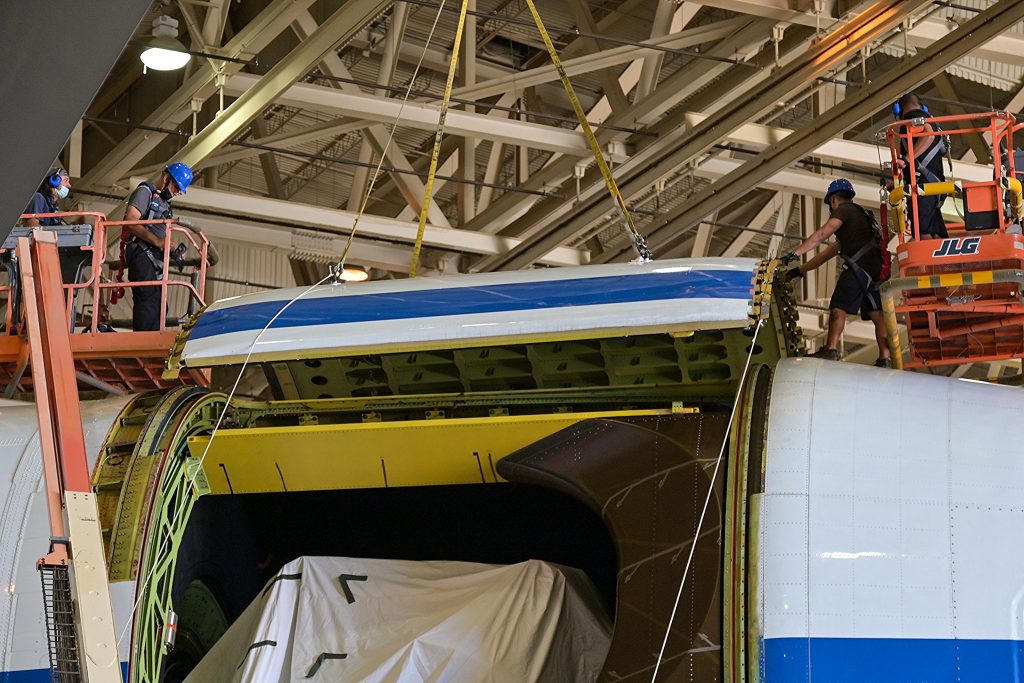The Stratospheric Observatory for Infrared Astronomy, or SOFIA, the largest airborne observatory in the world, is in its annual maintenance period at NASA’s Armstrong Flight Research Center (AFRC) in California. During the six weeks of down time when there are no science flights, SOFIA will undergo both routine aircraft maintenance and specialized procedures unique to the aircraft.

This is the first year that the annual maintenance for the observatory will be performed during one period, rather than during multiple shorter maintenance periods throughout the year. This is an example of some of the strategic changes designed to enhance efficiency and ensure there are more hours for science observations. Executing all of the care and maintenance of the observatory during one period requires meticulous planning, coordination, and teamwork.
“Our biggest challenges are coordination and balancing our priorities,” said Paul Martinez, the operations manager for the observatory and a member of the AFRC-based SOFIA team. “We have some highly important, specialized maintenance for one of SOFIA’s unique features—the upper rigid door that opens to allow the telescope to view the sky—as well as other general aircraft maintenance activities that are necessary for flight airworthiness.”
The upper rigid door is one of the key aspects of SOFIA that allows the observatory to operate. The door was designed and tested at NASA’s Ames Research Center in California using its wind tunnel facilities. One of the engineers who led the development of the upper rigid door even returned to the SOFIA team from retirement to assist in its maintenance.
“This is the largest port that has ever flown on an aircraft,” said Paul Fusco, former SOFIA team engineer. It is a really thrilling aviation innovation. This is the first time the door has been taken off the aircraft since 2008.”
In fact, this is the door’s first maintenance since it was installed, as it has had a very high-performance life to this point. During the period when the door is off the aircraft, the bearings that allow the door to roll open will be inspected, cleaned, and replaced, as necessary. The team expects another period of high performance for the door.

“The maintenance period is an incredibly team-oriented effort,” said Jonathan Brown, SOFIA’s systems engineer and integration lead. “Whether it’s the telescope, mission systems, or avionics technicians, without everyone playing their part, we would not be successful.”
All of the SOFIA mission partners have worked together for months, meticulously planning every event that will happen during this maintenance period, based both on the needs and requirements for the aircraft as well as other aspects, like the telescope, that are unique to this facility. Now that the maintenance period is here, the team is working seamlessly to do the work necessary to ensure SOFIA is flight-ready and able to do the best science possible for the rest of the year.
“Down times are a time of improvements, not just maintenance,” said Michael Huetwohl, the DSI team lead at NASA’s Armstrong Flight Research Center in Palmdale, California, and the SOFIA telescope manager.
In addition to the need for maintenance on the aircraft and observatory systems, improvements and innovations can be implemented to ensure that SOFIA can do all of the science demanded by the astronomical community.
“What attracted me to SOFIA after 25 years in the semi-conductor industry,” Huetwohl said, “is the opportunity to strive for the best solution.”
The team is working to ensure human safety and flight worthiness as well as staying on the cutting edge of technology for astronomical observation in the mid- and far-infrared wavelengths of light.
While the aircraft and telescope are undergoing their routine and specialized maintenance, USRA is using the downtime to prepare for upcoming observations as well as incorporating the newest facility instrument into the observatory, the Echelon-Cross-Echelle Spectrograph, or EXES. EXES was initially operated by a group of scientists and engineers from the University of California, Davis, and has flown on SOFIA to study Mars’ atmospheric water loss and the chemistry of the universe. Now that EXES is transitioning to a facility instrument, the SOFIA Science Center needs to gain proficiency in using the instrument and to develop maintenance manuals and software to fully incorporate the instrument into the observatory.
This time-lapse video shows the SOFIA team attaching the upper rigid door to the crane then lifting and gently lowering the door onto the stand for its inspection and servicing. This is one of the key activities during SOFIA’s downtime. Like all of SOFIA’s maintenance, this event took meticulous planning and teamwork by a large group of experts. Video Credit: NASA/Agnew.
SOFIA is a joint project of NASA and the German Space Agency at DLR. DLR provides the telescope, scheduled aircraft maintenance, and other support for the mission. NASA’s Ames Research Center in California’s Silicon Valley manages the SOFIA program, science, and mission operations in cooperation with the Universities Space Research Association, headquartered in Columbia, Maryland, and the German SOFIA Institute at the University of Stuttgart. The aircraft is maintained and operated by NASA’s Armstrong Flight Research Center Building 703, in Palmdale, California.
